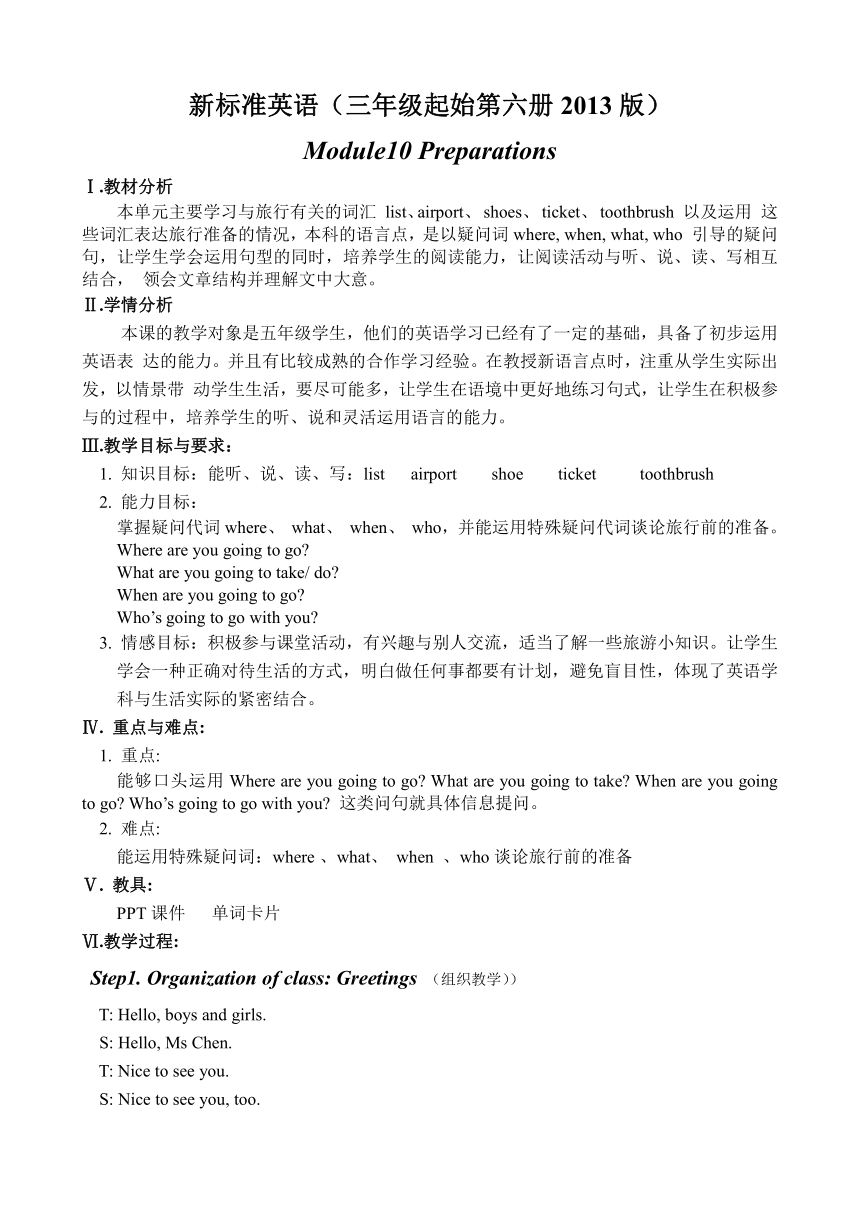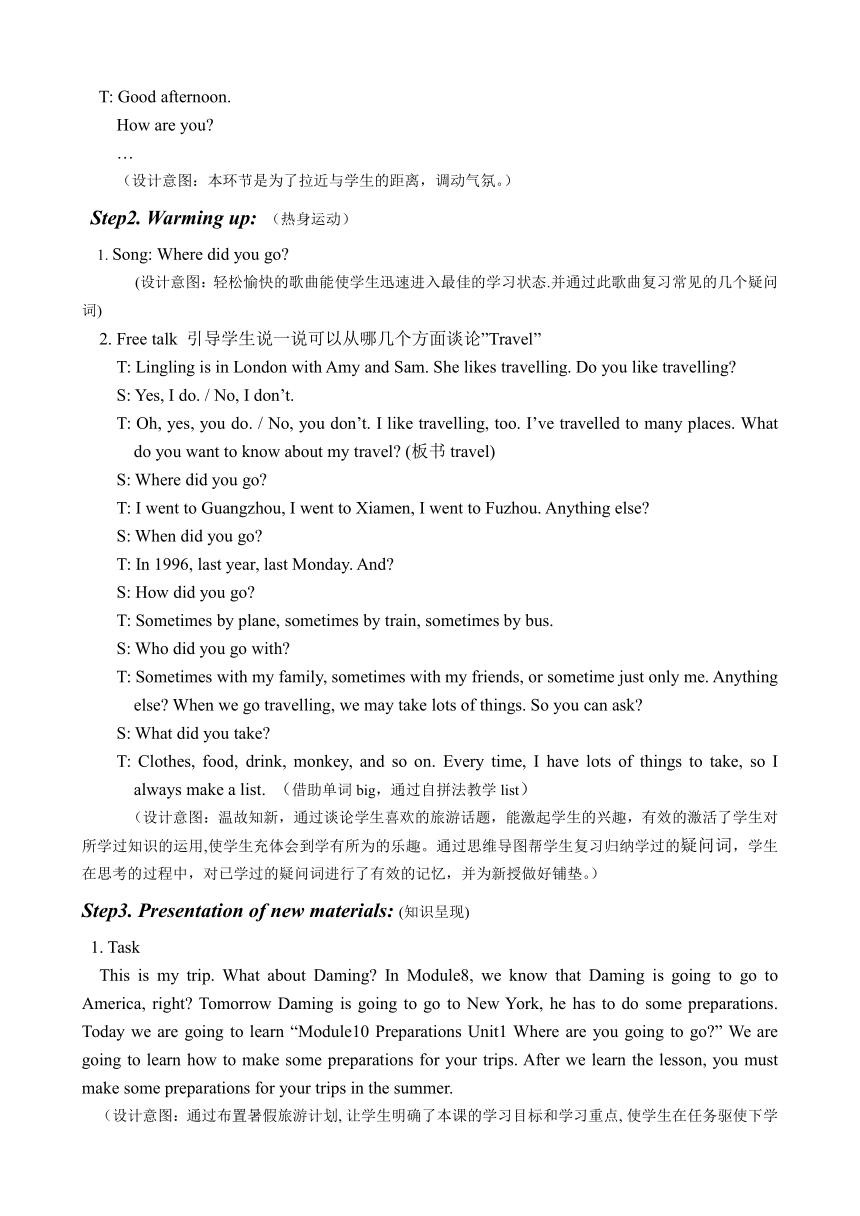Module 10 Unit 1 Where are you going to go? 教案
文档属性
| 名称 | Module 10 Unit 1 Where are you going to go? 教案 |  | |
| 格式 | zip | ||
| 文件大小 | 39.2KB | ||
| 资源类型 | 教案 | ||
| 版本资源 | 外研版(三年级起点) | ||
| 科目 | 英语 | ||
| 更新时间 | 2021-03-07 22:13:15 | ||
图片预览


文档简介
新标准英语(三年级起始第六册2013版)
Module10
Preparations
Ⅰ.教材分析
本单元主要学习与旅行有关的词汇
list、airport、
shoes、
ticket、
toothbrush
以及运用
这些词汇表达旅行准备的情况,本科的语言点,是以疑问词?where,
when,
what,
who
引导的疑问句,让学生学会运用句型的同时,培养学生的阅读能力,让阅读活动与听、说、读、写相互结合,
领会文章结构并理解文中大意。
Ⅱ.学情分析
?本课的教学对象是五年级学生,他们的英语学习已经有了一定的基础,具备了初步运用英语表
达的能力。并且有比较成熟的合作学习经验。在教授新语言点时,注重从学生实际出发,以情景带
动学生生活,要尽可能多,让学生在语境中更好地练习句式,让学生在积极参与的过程中,培养学生的听、说和灵活运用语言的能力。
Ⅲ.教学目标与要求:
1.
知识目标:能听、说、读、写:list
airport
shoe
ticket
toothbrush
2.
能力目标:
掌握疑问代词?where、
what、
when、
who,并能运用特殊疑问代词谈论旅行前的准备。
Where
are
you
going
to
go?
What
are
you
going
to
take/
do?
When
are
you
going
to
go?
Who’s
going
to
go
with
you?
3.
情感目标:积极参与课堂活动,有兴趣与别人交流,适当了解一些旅游小知识。让学生学会一种正确对待生活的方式,明白做任何事都要有计划,避免盲目性,体现了英语学科与生活实际的紧密结合。
Ⅳ.
重点与难点:
1.
重点:
能够口头运用Where
are
you
going
to
go?
What
are
you
going
to
take?
When
are
you
going
to
go?
Who’s
going
to
go
with
you?
这类问句就具体信息提问。
2.
难点:
能运用特殊疑问词:where?、what、
when
、who谈论旅行前的准备
Ⅴ.
教具:
PPT课件
单词卡片
Ⅵ.教学过程:
Step1.
Organization
of
class:
Greetings
(组织教学))
T:
Hello,
boys
and
girls.
S:
Hello,
Ms
Chen.
T:
Nice
to
see
you.
S:
Nice
to
see
you,
too.
T:
Good
afternoon.
How
are
you?
…
(设计意图:本环节是为了拉近与学生的距离,调动气氛。)
Step2.
Warming
up:
(热身运动)
1.
Song:
Where
did
you
go?
(设计意图:轻松愉快的歌曲能使学生迅速进入最佳的学习状态.并通过此歌曲复习常见的几个疑问词)
2.
Free
talk
引导学生说一说可以从哪几个方面谈论”Travel”
T:
Lingling
is
in
London
with
Amy
and
Sam.
She
likes
travelling.
Do
you
like
travelling?
S:
Yes,
I
do.
/
No,
I
don’t.
T:
Oh,
yes,
you
do.
/
No,
you
don’t.
I
like
travelling,
too.
I’ve
travelled
to
many
places.
What
do
you
want
to
know
about
my
travel?
(板书travel)
S:
Where
did
you
go?
T:
I
went
to
Guangzhou,
I
went
to
Xiamen,
I
went
to
Fuzhou.
Anything
else?
S:
When
did
you
go?
T:
In
1996,
last
year,
last
Monday.
And?
S:
How
did
you
go?
T:
Sometimes
by
plane,
sometimes
by
train,
sometimes
by
bus.
S:
Who
did
you
go
with?
T:
Sometimes
with
my
family,
sometimes
with
my
friends,
or
sometime
just
only
me.
Anything
else?
When
we
go
travelling,
we
may
take
lots
of
things.
So
you
can
ask?
S:
What
did
you
take?
T:
Clothes,
food,
drink,
monkey,
and
so
on.
Every
time,
I
have
lots
of
things
to
take,
so
I
always
make
a
list.
(借助单词big,通过自拼法教学list)
(设计意图:温故知新,通过谈论学生喜欢的旅游话题,能激起学生的兴趣,有效的激活了学生对所学过知识的运用,使学生充体会到学有所为的乐趣。通过思维导图帮学生复习归纳学过的疑问词,学生在思考的过程中,对已学过的疑问词进行了有效的记忆,并为新授做好铺垫。)
Step3.
Presentation
of
new
materials:
(知识呈现)
1.
Task?
This
is
my
trip.
What
about
Daming?
In
Module8,
we
know
that
Daming
is
going
to
go
to
America,
right?
Tomorrow
Daming
is?going?to?go?to?New
York,
he
has?to?do
some
preparations.
Today
we
are
going
to
learn
“Module10
Preparations
Unit1
Where
are
you
going
to
go?”
We
are
going
to
learn
how
to
make
some
preparations
for
your
trips.
After
we
learn
the
lesson,
you
must
make
some
preparations
for
your
trips
in
the
summer.
(设计意图:通过布置暑假旅游计划,?让学生明确了本课的学习目标和学习重点,?使学生在任务驱使下学习。同时设计这一任务贴近学生的生活,增加了学生学习的兴趣和动力。)?
2.
教授新课文
①PPT:
T:
Who
are
they?
S:
They’re
Daming
and
his
grandma.
T:
Daming
is
talking
with
his
grandma
on
the
phone.
②播放CD-ROM。学生带着问题认真听
Is
Daming
ready
for
his
trip
tomorrow?
③
Watch
CD-ROM,
listen
again
and
underline
“What
did
Grandma
ask?”
Where
are
you
going
to
go?
What
are
you
going
to
take?
When
are
you
going
to
go
to
the
airport?
Who’s
going
to
go
to
the
airport?
Answer
these
questions
(
T—Grandma,
S—Daming
)
T:
Where
are
you
going
to
go?
S:
To
the
airport.
(借助单词hair与short教学airport)
T:
What
are
you
going
to
take?
Did
you
take
clothes?
S:
Yes,
I
did.
T:
Did
you
take
shoes?
(出示单词卡,直观教学shoe)
S:
Yes,
I
did.
T:
Did
you
take
presents?
S:
Yes,
I
did.
T:
Did
you
take
tickets?
(借助单词pocket,通过自拼法教学ticket)
S:
Yes,
I
did.
T:
Did
you
take
passport?
(借助单词class与airport,通过自拼法教学passport)
S:
Yes,
I
did.
T:
Did
you
take
toothbrush?
(借助单词too与bus,通过自拼法教学tooth与brush)
S:
Yes,
I
did.
T:
So
you
take…
S:
Clothes,
shoes,
present,
ticket,
passport,
toothbrush.
T:
When
are
you
going
to
go
to
the
airport?
S:
At
7
o’clock
tomorrow
morning.
T:
Who’s
going
to
go
to
the
airport?
S:
Oh,
me.
I’m
going.
④
Listen
and
imitate
⑤
Read
the
dialogue
in
groups
⑥
Act
out
the
dialogue.
Boys
for
Daming,
Girls
for
Grandma
(设计意图:问题的设置帮助学生在听录音的过程中明确听音目的和听音重点,通过让学生先整体感知课文,再学习重点句型,这样的方式对培养学生的听说能力起到较大功效。同时打破将单词提出来进行单独教学的方式,将其放在为旅行做准备的情景中进行教学,消除学生学习新单词的乏味感。)
Step4
Consolidation:
(总结)
1.
本模块主要句型:谈论旅行前的准备。
Where
are
you
going
to
go?
What
are
you
going
to
take?
When
are
you
going
to
go?
Who’s
going
to
go
with
you?
2.
Say
a
chant:
Where
are
you
going
to
go?
I’m
going
to
go
to
the
airport.
What
are
you
going
to
take?
Clothes,
shoes,
present,
ticket,
passport
and
toothbrush.
When
are
you
going
to
go?
At
seven
o’clock
tomorrow
morning.
Who’s
going
to
go
to
the
airport?
Oh,
it’s
me.
(设计意图:通过节奏感强的chant,不仅活跃了课堂气氛,还帮助学生轻松地巩固总结了本课的重难点。)
3.
Preparation
for
your
trip
Fill
in
the
blank,
then
ask
someone?to?be
reporters
and
interview
classmates
or
teachers.
(设计意图:通过pair
work了解班级同学暑假的旅游计划,完成课前布置的任务,同时通过小记者活动,将知识联系到实际生活中,让学生在真实语境下运用语言,从而达到语言习得的目的。)
Step5
Homework:
1.
Copy
new
words:
list
airport
shoe
ticket
toothbrush
2.
Listen?to?the?tape?and?read?the?text?fluently.
3.
Make
a
preparation
for
Children’s
Day
(设计意图:把本课内容延伸至生活,通过说,读,写练习进一步巩固本课的知识。)
板书设计:
Module10
Preparations
Unit1?Where?are?you?going?to?go?
My
trip
Where:
When:
(
in
June
in
July
in
August)
How:
(
by
bus
by
car
by
train
by
plane
by
ship)
Who:
What:
clothes
shoes
present
tickets
passport
toothbrush
travel
Where
When
How
Who
What
To
the
airport
By
…
At
7
o’clock
tomorrow
morning
Me
List
Module10
Preparations
Ⅰ.教材分析
本单元主要学习与旅行有关的词汇
list、airport、
shoes、
ticket、
toothbrush
以及运用
这些词汇表达旅行准备的情况,本科的语言点,是以疑问词?where,
when,
what,
who
引导的疑问句,让学生学会运用句型的同时,培养学生的阅读能力,让阅读活动与听、说、读、写相互结合,
领会文章结构并理解文中大意。
Ⅱ.学情分析
?本课的教学对象是五年级学生,他们的英语学习已经有了一定的基础,具备了初步运用英语表
达的能力。并且有比较成熟的合作学习经验。在教授新语言点时,注重从学生实际出发,以情景带
动学生生活,要尽可能多,让学生在语境中更好地练习句式,让学生在积极参与的过程中,培养学生的听、说和灵活运用语言的能力。
Ⅲ.教学目标与要求:
1.
知识目标:能听、说、读、写:list
airport
shoe
ticket
toothbrush
2.
能力目标:
掌握疑问代词?where、
what、
when、
who,并能运用特殊疑问代词谈论旅行前的准备。
Where
are
you
going
to
go?
What
are
you
going
to
take/
do?
When
are
you
going
to
go?
Who’s
going
to
go
with
you?
3.
情感目标:积极参与课堂活动,有兴趣与别人交流,适当了解一些旅游小知识。让学生学会一种正确对待生活的方式,明白做任何事都要有计划,避免盲目性,体现了英语学科与生活实际的紧密结合。
Ⅳ.
重点与难点:
1.
重点:
能够口头运用Where
are
you
going
to
go?
What
are
you
going
to
take?
When
are
you
going
to
go?
Who’s
going
to
go
with
you?
这类问句就具体信息提问。
2.
难点:
能运用特殊疑问词:where?、what、
when
、who谈论旅行前的准备
Ⅴ.
教具:
PPT课件
单词卡片
Ⅵ.教学过程:
Step1.
Organization
of
class:
Greetings
(组织教学))
T:
Hello,
boys
and
girls.
S:
Hello,
Ms
Chen.
T:
Nice
to
see
you.
S:
Nice
to
see
you,
too.
T:
Good
afternoon.
How
are
you?
…
(设计意图:本环节是为了拉近与学生的距离,调动气氛。)
Step2.
Warming
up:
(热身运动)
1.
Song:
Where
did
you
go?
(设计意图:轻松愉快的歌曲能使学生迅速进入最佳的学习状态.并通过此歌曲复习常见的几个疑问词)
2.
Free
talk
引导学生说一说可以从哪几个方面谈论”Travel”
T:
Lingling
is
in
London
with
Amy
and
Sam.
She
likes
travelling.
Do
you
like
travelling?
S:
Yes,
I
do.
/
No,
I
don’t.
T:
Oh,
yes,
you
do.
/
No,
you
don’t.
I
like
travelling,
too.
I’ve
travelled
to
many
places.
What
do
you
want
to
know
about
my
travel?
(板书travel)
S:
Where
did
you
go?
T:
I
went
to
Guangzhou,
I
went
to
Xiamen,
I
went
to
Fuzhou.
Anything
else?
S:
When
did
you
go?
T:
In
1996,
last
year,
last
Monday.
And?
S:
How
did
you
go?
T:
Sometimes
by
plane,
sometimes
by
train,
sometimes
by
bus.
S:
Who
did
you
go
with?
T:
Sometimes
with
my
family,
sometimes
with
my
friends,
or
sometime
just
only
me.
Anything
else?
When
we
go
travelling,
we
may
take
lots
of
things.
So
you
can
ask?
S:
What
did
you
take?
T:
Clothes,
food,
drink,
monkey,
and
so
on.
Every
time,
I
have
lots
of
things
to
take,
so
I
always
make
a
list.
(借助单词big,通过自拼法教学list)
(设计意图:温故知新,通过谈论学生喜欢的旅游话题,能激起学生的兴趣,有效的激活了学生对所学过知识的运用,使学生充体会到学有所为的乐趣。通过思维导图帮学生复习归纳学过的疑问词,学生在思考的过程中,对已学过的疑问词进行了有效的记忆,并为新授做好铺垫。)
Step3.
Presentation
of
new
materials:
(知识呈现)
1.
Task?
This
is
my
trip.
What
about
Daming?
In
Module8,
we
know
that
Daming
is
going
to
go
to
America,
right?
Tomorrow
Daming
is?going?to?go?to?New
York,
he
has?to?do
some
preparations.
Today
we
are
going
to
learn
“Module10
Preparations
Unit1
Where
are
you
going
to
go?”
We
are
going
to
learn
how
to
make
some
preparations
for
your
trips.
After
we
learn
the
lesson,
you
must
make
some
preparations
for
your
trips
in
the
summer.
(设计意图:通过布置暑假旅游计划,?让学生明确了本课的学习目标和学习重点,?使学生在任务驱使下学习。同时设计这一任务贴近学生的生活,增加了学生学习的兴趣和动力。)?
2.
教授新课文
①PPT:
T:
Who
are
they?
S:
They’re
Daming
and
his
grandma.
T:
Daming
is
talking
with
his
grandma
on
the
phone.
②播放CD-ROM。学生带着问题认真听
Is
Daming
ready
for
his
trip
tomorrow?
③
Watch
CD-ROM,
listen
again
and
underline
“What
did
Grandma
ask?”
Where
are
you
going
to
go?
What
are
you
going
to
take?
When
are
you
going
to
go
to
the
airport?
Who’s
going
to
go
to
the
airport?
Answer
these
questions
(
T—Grandma,
S—Daming
)
T:
Where
are
you
going
to
go?
S:
To
the
airport.
(借助单词hair与short教学airport)
T:
What
are
you
going
to
take?
Did
you
take
clothes?
S:
Yes,
I
did.
T:
Did
you
take
shoes?
(出示单词卡,直观教学shoe)
S:
Yes,
I
did.
T:
Did
you
take
presents?
S:
Yes,
I
did.
T:
Did
you
take
tickets?
(借助单词pocket,通过自拼法教学ticket)
S:
Yes,
I
did.
T:
Did
you
take
passport?
(借助单词class与airport,通过自拼法教学passport)
S:
Yes,
I
did.
T:
Did
you
take
toothbrush?
(借助单词too与bus,通过自拼法教学tooth与brush)
S:
Yes,
I
did.
T:
So
you
take…
S:
Clothes,
shoes,
present,
ticket,
passport,
toothbrush.
T:
When
are
you
going
to
go
to
the
airport?
S:
At
7
o’clock
tomorrow
morning.
T:
Who’s
going
to
go
to
the
airport?
S:
Oh,
me.
I’m
going.
④
Listen
and
imitate
⑤
Read
the
dialogue
in
groups
⑥
Act
out
the
dialogue.
Boys
for
Daming,
Girls
for
Grandma
(设计意图:问题的设置帮助学生在听录音的过程中明确听音目的和听音重点,通过让学生先整体感知课文,再学习重点句型,这样的方式对培养学生的听说能力起到较大功效。同时打破将单词提出来进行单独教学的方式,将其放在为旅行做准备的情景中进行教学,消除学生学习新单词的乏味感。)
Step4
Consolidation:
(总结)
1.
本模块主要句型:谈论旅行前的准备。
Where
are
you
going
to
go?
What
are
you
going
to
take?
When
are
you
going
to
go?
Who’s
going
to
go
with
you?
2.
Say
a
chant:
Where
are
you
going
to
go?
I’m
going
to
go
to
the
airport.
What
are
you
going
to
take?
Clothes,
shoes,
present,
ticket,
passport
and
toothbrush.
When
are
you
going
to
go?
At
seven
o’clock
tomorrow
morning.
Who’s
going
to
go
to
the
airport?
Oh,
it’s
me.
(设计意图:通过节奏感强的chant,不仅活跃了课堂气氛,还帮助学生轻松地巩固总结了本课的重难点。)
3.
Preparation
for
your
trip
Fill
in
the
blank,
then
ask
someone?to?be
reporters
and
interview
classmates
or
teachers.
(设计意图:通过pair
work了解班级同学暑假的旅游计划,完成课前布置的任务,同时通过小记者活动,将知识联系到实际生活中,让学生在真实语境下运用语言,从而达到语言习得的目的。)
Step5
Homework:
1.
Copy
new
words:
list
airport
shoe
ticket
toothbrush
2.
Listen?to?the?tape?and?read?the?text?fluently.
3.
Make
a
preparation
for
Children’s
Day
(设计意图:把本课内容延伸至生活,通过说,读,写练习进一步巩固本课的知识。)
板书设计:
Module10
Preparations
Unit1?Where?are?you?going?to?go?
My
trip
Where:
When:
(
in
June
in
July
in
August)
How:
(
by
bus
by
car
by
train
by
plane
by
ship)
Who:
What:
clothes
shoes
present
tickets
passport
toothbrush
travel
Where
When
How
Who
What
To
the
airport
By
…
At
7
o’clock
tomorrow
morning
Me
List
同课章节目录
- Module 1
- Unit 1 We lived in a small house.
- Unit 2 She didn't have a television.
- Module 2
- Unit 1 She learnt English.
- Unit 2 Mr Li was a teacher.
- Module 3
- Unit 1 She had eggs and sausages.
- Unit 2 Sam ate four hamburgers.
- Module 4
- Unit 1 Let's make a home library.
- Unit 2 We can find information from books and CDs.
- Module 5
- Unit 1 It's big and light.
- Unit 2 It's too big for you.
- Module 6
- Unit 1 I went there last year.
- Unit 2 She visited the Tianchi Lake.
- Module 7
- Unit 1 My father goes to work at eight o'clock eve
- Unit 2 I'll be home at seven o'clock.
- Module 8
- Unit 1 Will you help me?
- Unit 2 I made a kite.
- Module 9
- Unit 1 We laughed a lot.
- Unit 2 Mum bought new T-shirts for you.
- Module 10
- Unit 1 Where are you going to go?
- Unit 2 I'm in New York now.
- Review Module
- Unit 1
- Unit 2
